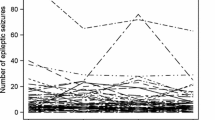Abstract
Four testing procedures are considered for testing the response rate of one sample correlated binary data with a cluster size of one or two, which often occurs in otolaryngologic and ophthalmologic studies. Although an asymptotic approach is often used for statistical inference, it is criticized for unsatisfactory type I error control in small sample settings. An alternative to the asymptotic approach is an unconditional approach. The first unconditional approach is the one based on estimation, also known as parametric bootstrap (Lee and Young in Stat Probab Lett 71(2):143–153, 2005). The other two unconditional approaches considered in this article are an approach based on maximization (Basu in J Am Stat Assoc 72(358):355–366, 1977), and an approach based on estimation and maximization (Lloyd in Biometrics 64(3):716–723, 2008a). These two unconditional approaches guarantee the test size and are generally more reliable than the asymptotic approach. We compare these four approaches in conjunction with a test proposed by Lee and Dubin (Stat Med 13(12):1241–1252, 1994) and a likelihood ratio test derived in this article, in regards to type I error rate and power for sample sizes from small to medium. An example from an otolaryngologic study is provided to illustrate the various testing procedures. The unconditional approach based on estimation and maximization using the test in Lee and Dubin (Stat Med 13(12):1241–1252, 1994) is preferable due to the power advantageous.




Similar content being viewed by others
References
Agresti A (2002) Categorical data analysis. Wiley series in probability and statistics, 2nd edn. Wiley, Hoboken
Barnard GA (1945) A new test for 2 \(\times \) 2 tables. Nature 156:177
Basu D (1977) On the elimination of nuisance parameters. J Am Stat Assoc 72(358):355–366
Cochran WG (1977) Sampling techniques, 3rd edn. Wiley,New York
Corcoran C, Ryan L, Senchaudhuri P, Mehta C, Patel N, Molenberghs G (2001) An exact trend test for correlated binary data. Biometrics 57(3):941–948
Donner A, Klar N (1993) Confidence interval construction for effect measures arising from cluster randomization trials. J Clin Epidemiol 46(2):123–131
Evans RJ, Forcina A (2013) Two algorithms for fitting constrained marginal models. Comput Stat Data Anal 66:1–7
Fisher RA (1970) Statistical methods for research workers, 14th edn. Hafner Press, New York
Jung SH, Ahn C (2000) Estimation of response probability in correlated binary data: a new approach. Drug Inf J 34:599–604
Kang SH, Park SM (2000) Exact likelihood ratio test of independence of binary responses within clusters. Comput Stat Data Anal 33:15–23
Kang S-HH, Chung S-JJ, Ahn CW (2005) Exact tests for one sample correlated binary data. Biom J Biometrische Zeitschrift 47(2):188–193
Lee EW, Dubin N (1994) Estimation and sample size considerations for clustered binary responses. Stat Med 13(12):1241–1252
Lee S, Young G (2005) Parametric bootstrapping with nuisance parameters. Stat Probab Lett 71(2):143–153
Lloyd CJ (2008a) A new exact and more powerful unconditional test of no treatment effect from binary matched pairs. Biometrics 64(3):716–723
Lloyd CJ (2008b) Exact p-values for discrete models obtained by estimation and maximization. Aust N Z J Stat 50(4):329–345
Lloyd CJ, Moldovan MV (2008) A more powerful exact test of noninferiority from binary matched-pairs data. Stat Med 27(18):3540–3549
Mak TK (1988) Analysing Intraclass Correlation for Dichotomous Variables. J R Stat Soc Ser C (Appl Stat) 37(3):344–352
Mandel EM, Bluestone CD, Rockette HE, Blatter MM, Reisinger KS, Wucher FP, Harper J (1982) Duration of effusion after antibiotic treatment for acute otitis media: comparison of cefaclor and amoxicillin. Pediatr Infect Dis 1(5):310–316
Qu Y, Piedmonte M, Williams G (1994) Small sample validity of latent variable models for correlated binary data. Commun Stat Simul Comput 23(1):243–269
Rosner B (1982) Statistical methods in ophthalmology: an adjustment for the intraclass correlation between eyes. Biometrics 38(1):105–114
Shan G (2013a) A note on exact conditional and unconditional tests for Hardy-Weinberg equilibrium. Hum Hered 76(1):10–17
Shan G (2013b) Exact unconditional testing procedures for comparing two independent Poisson rates. J Stat Comput Simul. doi:10.1080/00949655.2013.855776
Shan G (2013c) More efficient unconditional tests for exchangeable binary data with equal cluster sizes. Stat Probab Lett 83(2):644–649
Shan G, Ma C (2012) Unconditional tests for comparing two ordered multinomials. Stat Methods Med Res. doi:10.1177/0962280212450957
Shan G, Ma C (2013) Exact methods for testing the equality of proportions for binary clustered data from otolaryngologic studies. Stat Biopharm Res. doi:10.1080/19466315.2013.861767
Shan G, Ma C, Hutson AD, Wilding GE (2012) An efficient and exact approach for detecting trends with binary endpoints. Stat Med 31(2):155–164
Shan G, Ma C, Hutson AD, Wilding GE (2013) Some tests for detecting trends based on the modified BaumgartnerWeißSchindler statistics. Comput Stat Data Anal 57(1):246–261
Tang N-S, Tang M-L, Qiu S-F (2008) Testing the equality of proportions for correlated otolaryngologic data. Comput Stat Data Anal 52(7):3719–3729
Acknowledgments
The authors would like to thank the Editor and two referees for their valuable comments and suggestions that improved this article significantly.
Author information
Authors and Affiliations
Corresponding author
Appendix
Appendix
Likelihood ratio test statistic \(\mathbf{T}_\mathbf{LR}\). The log-likelihood is expressed as
Differentiating \(l(\pi , \rho )\) with respect to \((\pi , \rho )\) yields the score function
The unrestricted MLE of \((\pi , \rho )\), denoted by \((\hat{\pi }, \hat{\rho })\) is the solution to the following equations which can be obtained by Fishing-Score method,
After a lengthy algebra calculation, the \(\hat{\rho }\) can be derived as a solution of a third-order polynomial
where
and
We then compute the log-likelihoods for the solutions in the parameters’ space, and the parameter with the largest value is the solution. Another method may be used to derive the LR test (Evans and Forcina 2013).
Under null hypothesis \(H_0: \pi =\pi _0\), the MLE of \(\rho \) is given by
where \(f= (4N_{21}n_2+(N_{20}-N_{22})^2)\pi _0^2 + 2(N_{20}(N_{21}+2N_{22})-n_2(2N_{21}+N_{22}))\pi _0+(N_{21}+N_{22})^2\) and only keep the solution in the parameter space. When both \(\hat{\rho }_{H_0}\) are in the parameter space, the one with the larger null log likelihood is the solution.
Rights and permissions
About this article
Cite this article
Shan, G., Ma, C. Efficient tests for one sample correlated binary data with applications. Stat Methods Appl 23, 175–188 (2014). https://doi.org/10.1007/s10260-013-0251-6
Accepted:
Published:
Issue Date:
DOI: https://doi.org/10.1007/s10260-013-0251-6




